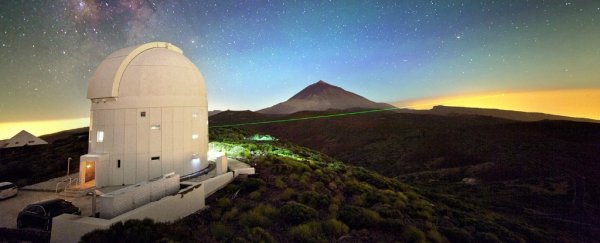Scientists have broken the world record for optical data transfer, beaming what's called 'twisted light' over a distance of 143 kilometres (almost 90 miles).
If you're scratching your head over what twisted light is, it's actually exactly what it sounds like: a beam of light where the particles aren't all travelling forward in a linear block, but are twisting as they go, like a corkscrew through the air.
The new milestone represents a 50-fold improvement on the previous record, according to researchers from the University of Vienna in Austria, and while they're not ready for real-world applications yet, these twisted beams of light could one day be used to send large volumes of data at blisteringly high speeds.
Also called an optical vortex, twisted light could improve current fibre optic technology because it allows more data to be sent simultaneously - separate channels of information could be broadcast at the same time, using different amounts of twist.
Scientists are still figuring out the practicalities of how such a system would work, because right now, one problem is beaming an optical vortex without the light (and therefore the data) being scrambled along the way.
One of the ways we could get around this is by using neural networks that can help to filter out transmission errors. With this kind of system, the team was able to transmit light through the air between the islands of La Palma and Tenerife in the Canary Islands, Spain, for a total distance of 143 kilometres (89 miles).
They even encoded a message in the corkscrew beam: "Hello, world." Aw.
 Credit: University of Vienna
Credit: University of Vienna
Having been trained using data from beams distorted by turbulence, their computer-powered neural network was able to successfully decode messages about 80 percent of the time.
That figure – and the overall distance – should get higher over time, as the technology and methods are further refined. The team used a green laser beam at the sending station in La Palmer, with the resulting magnified light collected on the wall of the Observatorio del Teide in Tenerife.
The experiment took 10 days in total, which means there's clearly room for improvement, seeing as that's about as fast as a smoke signal. Still, in science, you've gotta start somewhere.
In the future, this kind of technology could eventually allow for high-speed data transmission between satellites and Earth's surface, the scientists say.
"We don't consider this method as real communication, but merely the demonstration of the transmission quality of modes," write the researchers. "However, the application of state-of-the-art adaptive optics such as those used in simple and efficient intensity-based methods could further improve the link quality."
A paper detailing the research has been published on pre-print website arXiv.org, is currently awaiting peer-review.
